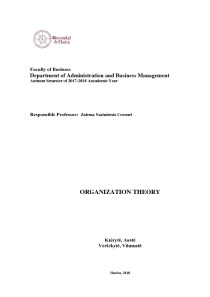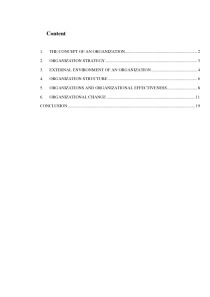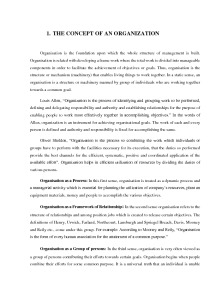Organization Theory



The concept of an organization. Organization strategy. External environment of an organization. Organization structure. Organizations and organizational effectiveness. Organizational change. Conclusion.
gathering the additional information on the problem and opportunity;
Innovation is widely recognised as one of the critical problemsfacing businesstoday. The process of innovation starts with the best idea produced by the creation process. It continues with the design of a product or service and process (Rozman, 2002: 124). A thorough feasibility analysis follows to determine whether the solution is feasible (Does the company have employees, material and other resources? Is a market available, etc.?). The last step is the verification of success (Will the innovation be profitable?). Following that, the implementation and control start. Similarly, Tidd, Bessant and Pavitt (2001: 52) determine the process as:
selection of best solution, feasibility study and verification of success;
Entrepreneurship is defined as a process or activity in which the entrepreneur makes an investment by risking his own money and name. Creativity and innovation and taking risk are also at the core of intrapreneurship. As already mentioned, large corporations have to make different changes to remain entrepreneurial. One of them is internal entrepreneurship or intrapreneurship, which issimilar to the entrepreneurship at the level of enterprises. Drucker (1992: 177-191) looks at intrapreneurship as spreading the entrepreneurial spirit within the enterprise thus making the ground for creativity and innovation.
Via intrapreneurship, motivation and support are given to creative and innovative employees to develop ideas and to turn them into products and services. The existence of intrapreneurship shows the inclination of the corporation toward innovation (Rutherford & Holt, 2007: 429-446). Some authors emphasise the importance of organisational culture and structures (e.g. Hornsby et al., 2002: 253-273) as well as management (e. g. DeYong & Hartog, 2007: 41-64) for the development of intrapreneurial units. At this point, the discussed organisational phenomena and their influences on creativity and innovation are obviously correlated and intertwined.
2. Management can also be called a social process that performs coordination, communication, control and planning functions that reveals the relationship between manager and subordinates;
3. A modern organization, a constantly changing, evolving, dynamic structure, ready to respond to rapidly changing business conditions at any time;
- Management Papers
- Microsoft Word 187 KB
- 2018 m.
- English
- 20 pages (5970 words)
- University
- Aiste

















